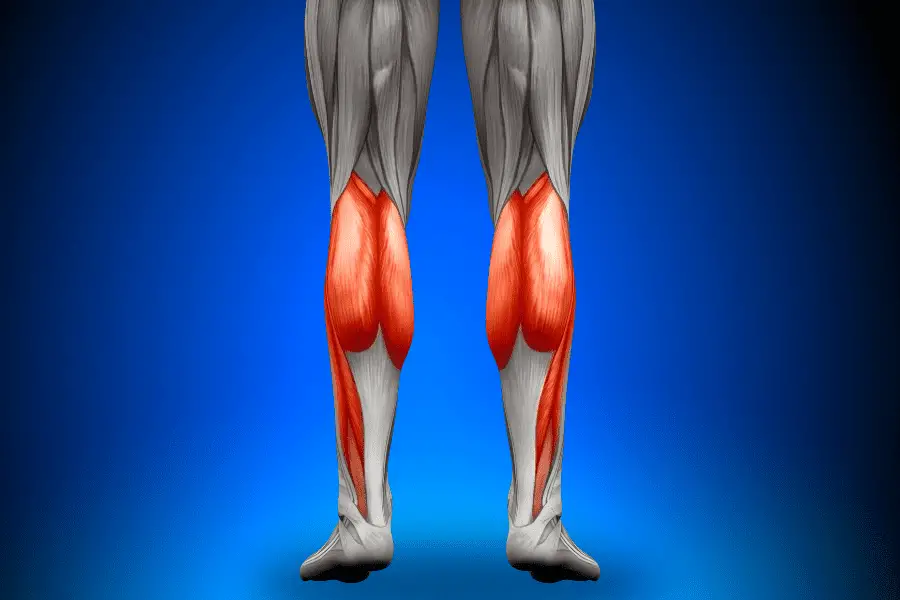Address
304 North Cardinal St.
Dorchester Center, MA 02124
Work Hours
Monday to Friday: 7AM - 7PM
Weekend: 10AM - 5PM
The calves are very important to how big your legs look in shorts and also for athletic performance. Many people still forget to train them properly though. You’ve noticed your calves are lagging behind the rest of your body and want to grow them but don’t want to spend too much time? Is twice a week enough? Here’s what you want to know.
Two calf workouts with exercises that directly target the calves is enough for muscle growth provided the intensity is correct. People that don’t walk/run a lot in the rest of their daily lives (hiking, football, etc), can benefit from adding a third calf workout.
Keep reading to find out what the correct intensity, amount of repetitions and sets is best for training calves.
So let’s say you want to grow your calves. That is why most people target their calves directly anyways. For athletic performance, just doing the sport you’re training for will be enough in 99% of the cases. So what do you have to to grow your calves. Is twice a week enough?
Two calf workouts a week done with proper intensity is enough to see muscle growth although three workouts is likely to give better results. More than three is possible but you’ll have to lower the training volume per workout so this makes the extra workouts less efficient. Unless you’re looking for huge calves, twice a week is enough.

Two workouts a week with proper intensity can be enough for the calves to grow although if you really want to focus on the calves, three might work better. Two workouts a week is going to be enough for the majority of people though. Three workouts will likely start cutting into the time and attention you can give to other body parts so that’s a decision you’ll have to make yourself.
The calves recover quite quickly and are actually hard to damage with training which is why they can handle more than most other muscles. Most muscle growth happens in the first 24-48 hours after a workout. Other muscles like the hamstrings can take longer but the calves are relatively small so they recover quite fast. With a 48 hour rest in between workouts, you could fit in 3 workouts a week. There is one caveat here. The first few weeks you train calves directly, you’ll probably be very sore especially if you’ve never trained them directly before. The first 2-3 weeks just do one workout until the soreness after a workout gets less.
More than three workouts is possible but you’ll have to significantly cut the amount of work you do per workout and for most people this is not a practical nor efficient use of their time and energy. With more than three workouts, you’ll see diminishing returns for every extra workout. So for moderate growth, two workouts a week is the sweet spot and for significant growth, three a week is good. Two hard workouts is better than three mediocre ones.
The calves are used for many other exercises besides direct calves exercises. Every step you take uses the calves. The heavier you are, the more work they’re doing already and likely the stronger they are. Also, sports that involve standing on your feet (pretty much all of them), will use your calves. So if any of the above applies to you, two dedicated workouts a week is going to be enough since they already get more stimulation through playing sports. If you are light and don’t play any sports, adding a third calf workout will help more (and you’ll be able to recover more easily).
As you might understand from above that two calf workouts (with calf isolation exercises) is enough to build muscle. One more workout a week might help you grow more but you’ll notice diminishing returns and potential recovery issues. More than 3 workouts a week is going to be problematic for many people if you do a decent amount of volume per workout especially if you also play a sport that hits the calves hard.

However, one thing to understand is that the amount of workouts doesn’t say much. Compare two people working out the same body part in any gym and there will be big differences in amount of sets, repetitions, weight and effort. One jumps up and down 2 times, the other does 8 heavy sets of calf raises. Those two people will have visibly different results in the future. However, more isn’t always better either.
So what do you actually need to grow your calves?
There are four main factors you should get right;
As said above, there are many exercises that use the calves. Most leg exercises will use the calves. But to really grow the calves, you have to do some isolation exercises on top of that. Most leg exercises only use the calves to stabilize the body but don’t take the calves through the full range of motion. So things like squatting and deadlifting will use the calves but not enough for muscle growth. To get your calves to grow, you need to add things like calf raises and maybe box jumps.
The calf muscles extend the foot (point your toes down) so that’s exactly what you have to do to isolate those muscles. There are a few different ways to do that though. Use a selection of 2 different exercises that directly target and isolate the calves. Keep in mind there are actually two different muscles in the calves that both do slightly different things so it’s best to pick one exercise that focusses more on one muscle and one for the other.
The amount of sets you do per workout and week is a very important variable for muscle growth.
For calves, about 4-6 heavy sets per week is enough for muscle maintenance but to see some growth, 8 is about the minimum effective dose. That’s 8 sets of direct calf exercises so other leg exercises don’t count. It also means heavy ‘working’ sets. Warm up sets don’t count.
For optimal growth with two workouts a week, about 16 sets per week is about the maximum. That’s per week so 8 sets per workout. With three workouts, 20 sets per week is about the maximum you can recover from.
You can see here that with an extra workout, the average amount of sets per workout has to be lower to make sure you can recover fully between workouts. If you’re not fully recovered, the extra workouts might even be detrimental.
Read more about optimal calf training volume here.
Calves should be trained with 8-20 repetitions per set, like most other muscles. Lower repetitions (with higher weight) tends to build more strength while higher repetitions (with less resistance) build more muscle.
Most people work out in the 8-15 rep range. This provides a balance between strength and muscle building. Of course you have to adjust the weight used for the rep range.
It’s a good idea to change up the rep ranges between different exercises. The exercises that use more muscle like an overhead press can be done with lower repetitions but higher weight. That way you strengthen the calves but also the surrounding muscles for good functional strength. Then on top of that you can do the isolation exercises with lighter weights but higher repetitions for the extra muscle growth. This provides a nice balance between building strength and size.

The last part of the puzzle is the weight or resistance to use. Most people will use machines, dumbbells or barbells to work out the calves but DIY solutions, bodyweight or resistance bands are also an option. In the end it doesn’t matter that much what you use, it’s all about how difficult it is for your to move that weight.
You want to use a resistance level/weight that you can complete the wanted amount of repetitions in a set with while keeping about 2-3 repetitions in reserve. Don’t go to failure on every set or even the last set of every exercise. Training to failure is a debated topic. Some research papers say it’s beneficial, others find it’s neutral while yet others say it’s detrimental. Sometimes it’s unavoidable to fail a lift but at least aim for that to happen on the later sets and not in the beginning of a workout.
This means you have to balance between the weight being heavy enough to be challenging but not too heavy so you can’t finish all the sets. It’s a fine line that will take a while to find. Calves are quite strong already because they have no trouble lifting your bodyweight even with just one leg. So you’ll find that relatively heavy weights are necessary to really exhaust the calves.
Possibly the most important thing for getting sustained muscle growth is progression. Muscle growth is the bodies way of adapting to the stress of the last workouts. That means the next workout should be a bit heavier than the last one to give the body a new level to adapt to.
The easiest way to do that is to add a small amount of weight to the exercises every workout. In the beginning, this will be pretty easy although after a while, adding weight becomes more difficult. Trying to increase the amount of repetitions can also be a good way to progress if a weight increase isn’t possible.